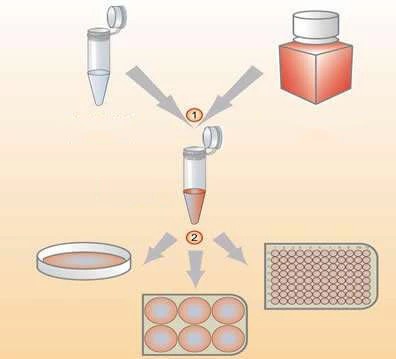Chemical transfection of other transfection reagents for cell transfection

Chemical transfection of other transfection reagents for cell transfection

Copyright © iCell Bioscience Inc, Shanghai 2018-2019
With the development of molecular biology, transfection has become a common tool for the study and control of cellular gene function and gene regulation. There are various kinds of transfection reagents in the market, but none of the transfection reagents can be applied to all kinds of cells to meet all the needs and objectives of the experiment, The composition and mechanism of transfection reagents have a significant influence on the transfection efficiency and cell physiology, which is an important basis for the selection of transfection reagents.
Transfection methods can be divided into chemical methods, physical methods (electroporation, microinjection, etc.) and virus-mediated methods. Chemical transfection based on various types of transfection reagents is described below.

Calcium phosphate transfection reagent
Its main principle of action is to form a calcium phosphate-DNA complex with DNA through precipitation reaction, adhere to the surface of the cell membrane, and enter the cytoplasm via endocytosis. The pH value, calcium ion concentration, DNA concentration, precipitation time, cell incubation time and even the addition order of each component may affect the results. Therefore, the exploration of experimental conditions and optimization time are long and the repeatability is poor.
Liposomal Transfection Reagents
Including neutral liposomes and cationic liposomes. Neutral liposomes use lipid membranes to encapsulate DNA and introduce lipids into the cell membrane. At present, the cationic liposome transfection reagent with positive electricity is widely used., DNA is not pre-embedded in liposomes, but negatively charged DNA is automatically bound to positively charged liposomes to form DNA - A cationic liposome complex that adsorbs to the surface of a negatively charged cell membrane and is introduced into the cell via endocytosis.
This method is simple, reproducible, and highly efficient in in vitro transfection, but has a certain degree of cytotoxicity and may interfere with cell metabolism. And the activity is affected by serum and serum needs to be removed.
Cationic polymer transfection reagents
A positively charged polymer and a negatively charged phosphate group of a nucleic acid form a positively charged complex that interacts with a negatively charged proteoglycan on the cell surface and enters the cell via endocytosis.
It is divided into dendritic cationic polymers and linear cationic polymers. The former has relatively high cytotoxicity and the latter has lower cytotoxicity, but its transfection efficiency is higher than that of liposome transfection, and it is also wider applicated
The above single-component transfection reagents are either focused on increasing efficiency or on reducing cytotoxicity.
A new generation of transfection reagents, not limited to a single component, mixed with different patented lipids (non-liposomes), plus protein components, and various proprietary ingredients, both with high transfection efficiency and samll cytotoxicityadvantages, simpler operation and high throughput.
Roche X-TremeGENE is the leader in a new generation of transfection reagents. The upgraded multi-component reagents combine high transfection efficiency and extremely low cytotoxicity, resulting in highly efficient conversion in more than 350 eukaryotic cell lines. The verification of the dyeing, especially for difficult-to-transfect cell lines, also performed well.
 Loading ....
Loading ....
